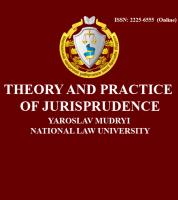Деякі правові аспекти комплексного освоєння підземного простору мегаполісів
Some legal aspects of complex development of underground space of megapolis
Author(s): I. IgnatenkoSubject(s): Human Rights and Humanitarian Law
Published by: Національний юридичний університет імені Ярослава Мудрого
Keywords: underground construction; the vertical zoning; town; urban planning; planning
Summary/Abstract: Analysis of current legislation and jurisprudence practiceshows that the use of underground space of cities creates a significant number ofproblems. In this article, we try to describe most typical of them.Recent research and publications analysis. The choice of the article's subjectdefined by importance of problems raised in it, some aspects of which are submittedin works members of land law study as P.F. Kulinich, R.I. Marusenko,A.M. Miroshnichenko A.I. Ripenko, N.V. Shulga and others.Paper objective. The article's subject is studying of a number of law issues forcomplex development of underground space.Paper main body. Today is a time to solve problems in the field of citydevelopment, we should refuse old forms of thinking and switch to the reasonablelimits of vertical zoning, by increasing the permissible storeys, on the basis of deepspaceorganization of the whole system objects of development as the organic whole,which consists housing and all necessary social, industrial and engineeringinfrastructure, created in the underground level.Vertical zoning should be included in the zoning plans. It should be noted thatin zoning plans must consider typology and characteristics of underground structuresthrough the adoption of urban planning regulations.Except making changes in the zoning plans provisions about undergrounddevelopment, should also adopt plenty of standart acts or making additions to existingones for underground construction. Since the law allows to decide the simultaneousoperation of aboveground and underground parts of the land area, but only "to acertain extent", without giving specific and exhaustive answers to all questions thatarise in this regard.There is also need to develop engineering-geological mapping of urbanunderground space that will allow to evaluate the possibility of a secure building in aparticular location objects of underground space and significantly reduce the lengthof the stage frills building cycle.Underground spaces with objects placed on them are not subjects toregistration as land and can not be displayed in the cadastral system. Thus, revealeditself the need to use some 3D features in existing cadastral system. The first step forintroduction of this system are alreadey maded, in particular, introduced by the StateLand Cadastre and the State registry, the next step will be introduction of accountingand registration of realty objects in three dimensions.Conclusions of the research. In Ukraine there are several problems that holdscomplex development of underground space. First of all, it is a complete lack offundamental documents defining prospects in elaboration of undergroundconstruction. A lot of problems are in the technical regulation: there is no regulationrequirements for construction of large number of objects just because earlier inUkraine there were not built at all. In addition, there are no legislative acts regulatinginvestment in the construction of underground structures, allocation of plots,obtaining ownership of the facility and more.
Journal: Теорія і практика правознавства
- Issue Year: 2/2015
- Issue No: 08
- Page Range: 12-12
- Page Count: 13
- Language: Ukrainian

